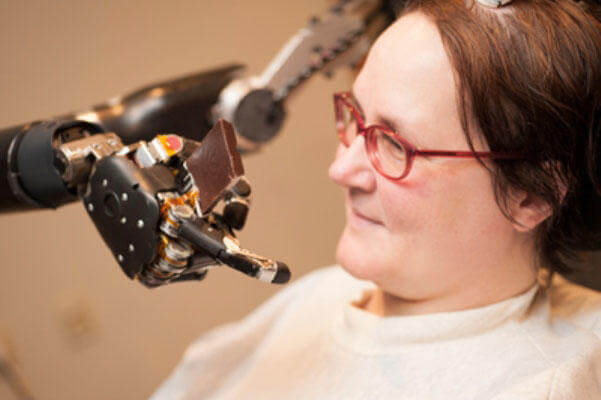Jan Scheuermann, a quadriplegic and pioneering patient for an experimental Pentagon robotics program, continues to break ground in freeing the mind from the body.
The 55-year-old mother of two in 2012 agreed to let surgeons implant electrodes on her brain to control a robotic arm. More recently, she flew an F-35 Joint Strike Fighter simulator using nothing but her thoughts, an official said.
Arati Prabhakar, director of the Defense Advanced Research Projects Agency, cited the breakthrough last week at the first annual Future of War conference. The event was organized by the New America Foundation, a nonpartisan research group in Washington, D.C.
Scheuermann, who became paralyzed years ago from a rare genetic disease, has tolerated the two pea-sized implants on her left motor cortex "very well," Prabhakar said, allowing her to extend her participation in the DARPA project.
While the left motor cortex is understood to control the movement on the right side of the body, Scheuermann was able to manipulate both right- and left-handed versions of the robotic limb, Prabhakar said.
But the experiments aren't limited to prosthetics. Indeed, so-called neural signaling is at the heart of the research.
So Scheuermann decided she wanted to try flying a simulator of the F-35 Joint Strike Fighter, Prabhakar said, which is the Pentagon's newest fighter jet and its most expensive weapons acquisition program.
"Instead of thinking about controlling a joystick, which is what our ace pilots do when they're driving this thing, Jan's thinking about controlling the airplane directly," Prabhakar said. "For someone who's never flown -- she's not a pilot in real life -- she's flying that simulator directly from her neural signaling."
Prabhakar said the research is far from becoming reality. Even so, she acknowledged that it raises fundamental moral and ethical questions about the intersection of biology and robotics.
"In doing this work, we've also opened this door," she said. "We can now see a future where we can free the brain from the limitations of the human body and I think we can all imagine amazing good things and amazing potential bad things that are on the other side of that door."
Geoffrey Ling, director of the biological technologies at DARPA and one of the lead scientists behind the project, said he was just as excited when he saw Scheuermann first control the robotic arm as he was when he watched the live television broadcast of Neil Armstrong walking on the moon.
"I had the same tingles because I realized that we have now stepped over a great threshold into what's possible and, very importantly, what patients can now expect in terms of restoration -- this is a very important part -- not rehabilitation, but restoration," the retired Army colonel said during a 2012 episode of CBS news program, "60 Minutes."
As for Scheuermann, who participates in the research through a University of Pittsburgh Medical Center study, she's happy to play the role of pioneering patient.
"I've always believed there's a purpose to my illness," she told CBS. “I didn't think I would ever find out what it was in my lifetime."
She added, "And here came this study where they needed me. You know, they couldn't just pick any Tom, Dick or Harry off the street. In a few years, the quadriplegics and the amputees that this is going to help -- the Department of Defense is funding some of this for vets -- to be of use to them, in service to them, what an honor."
-- Brendan McGarry can be reached at brendan.mcgarry@military.com



























